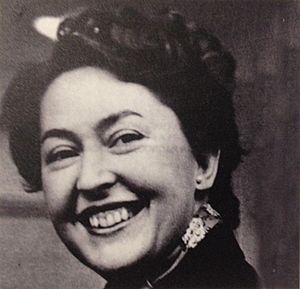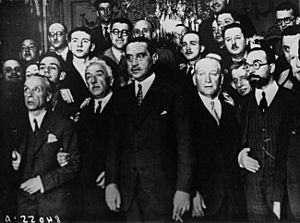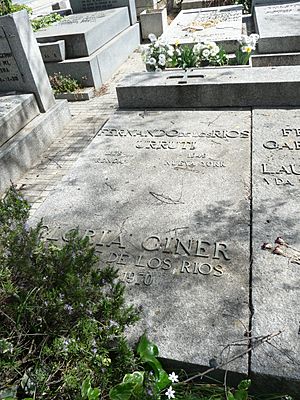Fernando de los Ríos facts for kids
Quick facts for kids
Fernando de los Ríos Urruti
|
|
|---|---|
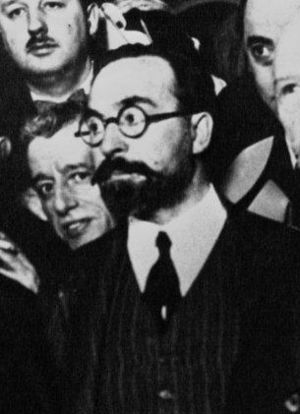 |
|
| Deputy for Granada | |
| In office 24 June 1919 – 2 October 1920 |
|
| Deputy for Madrid | |
| In office 28 May 1923 – 15 September 1923 |
|
| National Assembly Representative | |
| In office 10 October 1927 – 29 October 1927 |
|
| Deputy for Granada | |
| In office 7 July 1931 – 2 February 1939 |
|
| Minister of Justice | |
| In office 14 April 1931 – 16 December 1931 |
|
| Preceded by | Indalecio Prieto |
| Succeeded by | Álvaro de Albornoz |
| Minister of Public Education and Fine Arts | |
| In office 16 December 1931 – 12 June 1933 |
|
| Preceded by | Marcelino Domingo |
| Succeeded by | Francisco Barnés Salinas |
| Minister of State (Foreign Minister) | |
| In office 12 June 1933 – 12 September 1933 |
|
| Preceded by | Luis de Zulueta |
| Succeeded by | Claudio Sánchez-Albornoz |
| Personal details | |
| Born | 8 December 1879 Ronda, Malaga, Spain |
| Died | 31 May 1949 (aged 69) New York City, New York, USA |
| Spouse | Gloria Giner de los Ríos García |
| Occupation | Politician |
| Signature | |
Fernando de los Ríos Urruti (born December 8, 1879 – died May 31, 1949) was an important Spanish professor and politician. He was a member of the Socialist party. He served as a government minister for Justice, Education, and Foreign Affairs between 1931 and 1933. This was during the early years of the Second Spanish Republic. Later, during the Spanish Civil War (1936–1939), he became the Spanish Ambassador to France and then to the United States.
Contents
Early Life and Education (1879–1918)
Fernando de los Ríos Urruti was born into a well-off family in Ronda, Málaga, Spain, on December 8, 1879. His father was an army captain, and his mother came from a French Basque family. His family owned farms in Ronda.
Fernando's father died when he was only four years old. He went to primary school in Ronda. Later, he studied for his baccalaureate (a high school diploma) in Córdoba. His family then moved to Madrid. There, he attended the Institución Libre de Enseñanza (ILE), a special school founded by his distant uncle, Francisco Giner de los Ríos. His uncle had a big influence on Fernando.
Fernando studied medicine, then law and philosophy at the ILE. At the same time, he went to the University of Madrid. He became an atheist but kept a strong sense of right and wrong. He finished his university studies in 1901.
While working on his advanced degree, Fernando lived in Barcelona. He also wrote for a newspaper in Madrid. In 1907, he earned his doctorate with a paper on "Political Philosophy in Plato." He won a scholarship to study abroad. He went to the Sorbonne in Paris and the University of London. In London, he met the anarchist Peter Kropotkin. He also visited Belgium, Switzerland, and Germany. In Germany, he first learned about socialism, which is a political and economic idea about how society should be organized.

Back in Madrid in 1910, Fernando met Pablo Iglesias Posse. He was the leader of the Spanish Socialist Workers' Party (PSOE). Fernando started writing for the party's newspaper, El Socialista. In 1911, he became a professor of Political Law at the University of Granada. He legally changed his name from "del Río" to "de los Ríos."
On July 1, 1912, he married Gloria Giner de los Ríos García in Madrid. She was the niece of Francisco Giner, his influential uncle. They had one daughter, Laura, born in May 1913.
Fernando de los Ríos moved to Granada and began teaching at the university in October 1912. One of his students was the famous poet Federico García Lorca. Fernando was a liberal thinker. He believed that changes in power and the economy were needed to help people. This led him to support socialism.
Political Life (1918–1931)
Fernando de los Ríos officially joined the PSOE in 1918. He became known for his intelligence and speaking skills. He was elected as a representative for Granada in 1919. He traveled to Washington, D.C., in 1919 for a conference where the International Labour Organization was created.
In 1920, he became a member of the PSOE's national committee. He also attended a big meeting of the Unión General de Trabajadores (UGT), a major workers' union.
In July 1920, Fernando de los Ríos suggested that the PSOE should only join the Communist International if certain conditions were met. He and Daniel Anguiano visited Soviet Russia to discuss this. Their trip lasted from October to December 1920. In Moscow, Fernando de los Ríos met Vladimir Lenin, the leader of Russia. Fernando believed in a kind of socialism that valued human freedom. He told his hosts that the PSOE should be independent from Moscow. The Russian leaders did not agree with this.
When he returned, Fernando de los Ríos gave a negative report about joining the Communist International. The PSOE voted against the conditions demanded by Moscow. Some members who supported Moscow left the PSOE and formed the Communist Party of Spain. In 1921, Fernando published a book about his trip called Mi Viaje a la Rusia sovietista (My Trip to Soviet Russia). He was elected as a representative for Madrid in 1923.
Under the Dictatorship (1923–1931)
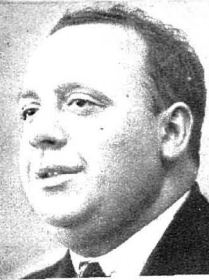
When a military dictator, Miguel Primo de Rivera, took power in September 1923, Fernando de los Ríos resigned from his university job. He believed that socialism could not exist without democracy. He was against the PSOE working with the dictatorship. However, most of the party disagreed with him.
In 1926, he published a book called El sentido humanista del socialismo (The Humanist Sense of Socialism). In it, he argued that educating workers and improving their morals was important before they could gain power.
In 1927, he was appointed to the National Assembly, a government body. However, the PSOE and the UGT protested against the dictatorship. Fernando de los Ríos resigned from the Assembly in October 1927. He believed the PSOE should work with other groups to oppose the dictatorship.
In 1929, he traveled to the United States with Federico García Lorca. After the dictator fell in March 1930, Fernando de los Ríos got his teaching job back at the University of Granada. He then moved to Madrid and became a professor there. In August 1930, he signed the Pact of San Sebastián, an agreement to bring about a republic. He was part of the Revolutionary Committee that tried to overthrow the monarchy in December 1930. When this attempt failed, he was put in prison.
The Second Republic (1931–1939)
In the local elections of April 12, 1931, Fernando de los Ríos was elected to the Madrid City Council. On April 14, 1931, he became a member of the Republic's Political Committee. He served as the Minister of Justice from April to December 1931. When he took office, he said he was there "to do justice."
As Minister of Justice, he helped solve a conflict with the Catholic Church. The new constitution limited the power of religious groups, especially their role in education. Fernando de los Ríos tried to calm the debate by pointing out the Church's good work in charity and medicine.

From December 1931 to June 1933, Fernando de los Ríos was the Minister of Public Education and Fine Arts. He started a big plan to create public schools to offer an alternative to Church schools. He supported Federico García Lorca's traveling theater group, La Barraca. He also created study centers, like the Granada Centre of Arabic Studies. He founded the International Summer University of Santander in 1932, which promoted liberal ideas.
Fernando de los Ríos was also concerned about the Sephardic Jews living in Greece and the eastern Mediterranean. These were descendants of Jews who were forced to leave Spain in 1492. He wanted to help them return to Spain. He even worked to invite Albert Einstein to teach in Spain in 1933. This invitation was seen as a way to make up for past wrongs and to challenge the persecution of Jews in Germany.
Fernando de los Ríos was the Foreign Minister from June to September 1933. He was reelected as a representative for Granada in November 1933. After a brutal strike by miners in Asturias in 1934, he was part of a committee that found proof of torture by the army. In 1935, he resigned from the PSOE Executive Committee because he disagreed with the party's alliances.
He was elected as a representative for Granada again in February 1936. When the Spanish Civil War began on July 18, 1936, he was teaching in Geneva. The government sent him to Paris, where he was in charge of the Spanish Embassy. He tried to convince the French government to sell weapons to the Republic, but he was not successful. In December 1936, he became the Spanish Ambassador to the United States. He stayed there until the end of the civil war.
Life in Exile (1939–1949)
After the civil war ended in 1939, Fernando de los Ríos left his role as ambassador. He accepted a job as a professor at the New School for Social Research in New York City. He moved his family to New York. His wife, Gloria Giner de los Ríos, taught Spanish at Columbia University.
In August 1945, when the first government of the Republic in exile was formed, Fernando de los Ríos was appointed Minister of State. He resigned in March 1946 because he refused to be part of a government that included the Communist Party of Spain. He then became an official observer for the Republican government in exile at the United Nations.
Fernando de los Ríos died on May 31, 1949, in New York City. His remains were brought back to Spain on June 28, 1980. He is buried in the Cementerio de la Almudena in Madrid.
Sources
See also
 In Spanish: Fernando de los Ríos para niños
In Spanish: Fernando de los Ríos para niños


